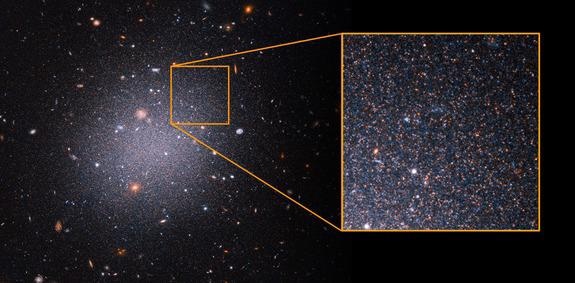Jun 18 2021
The most precise distance measurement yet of NGC1052-DF2 — the ultra-diffuse galaxy (UDG) — has clearly confirmed that it lacks dark matter.
 NGC1052-DF2. NASA, ESA, Z. Shen and P. van Dokkum (Yale University), and S. Danieli (Institute for Advanced Study). Image Credit: Institute for Advanced Study.
NGC1052-DF2. NASA, ESA, Z. Shen and P. van Dokkum (Yale University), and S. Danieli (Institute for Advanced Study). Image Credit: Institute for Advanced Study.
A team of researchers, headed by Zili Shen and Pieter van Dokkum from Yale University, and Shany Danieli, a NASA Hubble Fellow at the Institute of Advanced Study, obtained the newly measured distance of 22.1 ±1.2 megaparsecs.
Determining an accurate distance to DF2 has been key in supporting our earlier results. The new measurement reported in this study has crucial implications for estimating the physical properties of the galaxy, thus confirming its lack of dark matter.
Shany Danieli, NASA Hubble Fellow, Institute of Advanced Study
The results were published in the Astrophysical Journal Letters journal on June 9th, 2021. The results were obtained based on 40 orbits of NASA’s Hubble Space Telescope, with imaging performed by Advanced Camera for Surveys and a “tip of the red giant branch” (TRGB) analysis — the highest standard for such refined measurements.
Back in 2019, the researchers had published results, quantifying the distance to adjacent UDG NGC1052-DF4 (DF4) based on 12 Hubble orbits as well as TRGB analysis. This provided strong evidence regarding the absence of dark matter. This preferred technique builds on the researchers’ 2018 studies that depended on “surface brightness fluctuations” to measure the distance. The two galaxies were discovered by the team using the Dragon Telephoto Array deployed at the New Mexico Skies Observatory.
We went out on a limb with our initial Hubble observations of this galaxy in 2018. I think people were right to question it because it’s such an unusual result. It would be nice if there were a simple explanation, like a wrong distance. But I think it’s more fun and more interesting if it actually is a weird galaxy.
Pieter van Dokkum, Researchers, Yale University
Apart from confirming the previous findings on distance, the Hubble results suggested that the galaxies were located somewhat farther than previously believed. This assumption reinforced the case that these galaxies contain little to no dark matter. Some astronomers have claimed that if DF2 were closer to Earth, it would be less massive and intrinsically fainter. In such a case, the galaxy would require dark matter to account for the visualized effects of the total mass.
Dark matter is broadly known to be a critical component of galaxies. However, this latest analysis provides more evidence to suggest that its presence may not be inevitable. Although dark matter has not been directly observed yet, its gravitational effect is similar to a glue that holds the galaxies together and controls the movement of visible matter.
With respect to DF2 and DF4, the team was able to record the movement of stars based on stellar mass alone, indicating an absence or lack of dark matter. However, the detection of galaxies that lack dark matter will probably reveal the latter’s enigmatic nature and shed new light on galactic evolution.
Although similar in size to the Milky Way galaxy, DF2 and DF4 have total masses that account for only around 1% of the mass of the Milky Way. It was observed that these UDGs also accommodate a large number of particularly luminous globular clusters.
This study has created a significant amount of scholarly interest and also active discussion among supporters of alternative theories to dark matter, like the Modified Newtonian Dynamics (MOND). However, the recent research findings, including the relative distance of the two UDGs to NGC1052, appear to suggest that such alternative theories are less likely.
At present, there is little uncertainty in the researchers’ distance measurement given the use of the TRGB technique. As per fundamental physics, this technique relies on the observation of the burning red giant stars that produce a flash after burning through their helium supply that invariably occurs at the same level of brightness.
There’s a saying that extraordinary claims require extraordinary evidence, and the new distance measurement strongly supports our previous finding that DF2 is missing dark matter. Now it’s time to move beyond the distance debate and focus on how such galaxies came to exist.
Zili Shen, Researcher, Yale University
The researchers have planned to track more of these kinds of galaxies while considering several questions like: What do the UDGs reveal about standard cosmological models? How are they formed? How common are they and what other special properties do they have? Many more galaxies that lack dark matters will need to be disclosed in order to understand these mysteries and the ultimate question of what dark matter truly is.
Journal Reference:
Shen, Z., et al. (2021) A Tip of the Red Giant Branch Distance of 22.1 ± 1.2 Mpc to the Dark Matter Deficient Galaxy NGC 1052–DF2 from 40 Orbits of Hubble Space Telescope Imaging. The Astrophysical Journal Letters. doi.org/10.3847/2041-8213/ac0335.